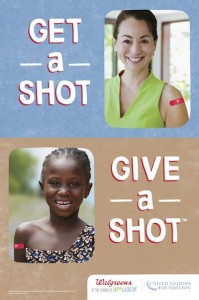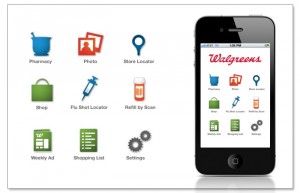 Alex Gourley, President of The Walgreen Company, addressed the capacity crowd at HIMSS15 in Chicago on 13th April 2015, saying his company’s goal is to “make good health easier.”
Alex Gourley, President of The Walgreen Company, addressed the capacity crowd at HIMSS15 in Chicago on 13th April 2015, saying his company’s goal is to “make good health easier.”
Remember that HIMSS is the “Health Information and Management Systems Society” — in short, the mammoth health IT conference that this year has attracted over 41,000 health computerfolk from around the world. So what’s a nice pharmacy like you, Walgreens, doing in a Place like McCormick amidst 1,200+ health/tech vendors?
If you believe that health is a product of lifstyle behaviors at least as much as health “care” services (what our team at Institute for the Future meta-analyzed for Robert Wood Johnson Foundation in the Healthcare 2010 report, page 47), then Walgreens participation at HIMSS is a no-brainer. The company sponsors the Connected Patient Gallery, a large piece of real estate on the HIMSS exhibition floor where the pharmacy showcased its many partners in kiosks demonstrating financial wellness (via CIGNA’s health cost financial tools), behavior management (with WebMD), health information access (through the digital Merck Manual), telehealth (via MDLIVE), and many other applications offered through Walgreens as a health channel.

Gourley studied pharmacy in Scotland and worked as a “Saturday assistant” at Boots the Chemist, working his way up the corporate ladder ultimately joining the board of Alliance Boots and becoming EVP of customer experience and daily living at Walgreens in 2013. He then became President of Walgreens.
The company has three over-arching objectives:
- To become “patient and customer led,” a lesson learned in working in retail pharmacy as that Saturday assistant. “The patient has always been at the center of community pharmacy,” Gourley told us.
- To develop a customer led culture. Gourley said that Walgreens must be “relevant” to its customers
- To become a strategic partner: real partnerships are very important to encourage innovation, Gourley said. “The reason Walgreens survivied 114 years is because it’s innovated. Innovation is important to Walgreens and always has been.”
One of Walgreens’ proudest projects has been the Get a Shot, Give a Shot program, a public health campaign to deliver vaccines to children in Africa who live in families with incomes, on average, of $3 or less a day.  On the topic of pharmacy’s role in delivering vaccines, Gourley explaiend that, “In two minutes, I can provide health care to a person that’s going to last them the rest of their lives” in a Walgreens pharmacy.
On the topic of pharmacy’s role in delivering vaccines, Gourley explaiend that, “In two minutes, I can provide health care to a person that’s going to last them the rest of their lives” in a Walgreens pharmacy.
The scale of Walgreens can drive health to 8 million customers every day through drugstores and the company’s digital assets. In total, the organization employs 70,000 healthcare service providers and 251,000 team members (employees).
Among those 8 million customers are “empowered customers,” who Gourley believes are “starting to change in five key ways:
- Purchase fulfillment, where waiting in line (queueing, in his native UK) is a thing of the past in the on-demand economy
- Demographics, with connected Millenials redefining convenience, how they take advice and from whom
- Behavior, with no single channel people use for reserach or purchase
- Wellness, such as owning your health through wearables and other connected devices
- Personalization, where people seek health solutions customized for them.
 On the personalization front, there are 82 million members in Balance Rewards, Walgreens loyalty program. In addition to gaining rewards through purchasing goods at Walgreens, enrollees can also accumulate points by using health wearables each day including the most popular brands like Fitbit, Jawbone UP, Withings scale, and others. (More about the Balance Rewards program can be found here).
On the personalization front, there are 82 million members in Balance Rewards, Walgreens loyalty program. In addition to gaining rewards through purchasing goods at Walgreens, enrollees can also accumulate points by using health wearables each day including the most popular brands like Fitbit, Jawbone UP, Withings scale, and others. (More about the Balance Rewards program can be found here).
Health Populi’s Hot Points: The Walgreens mobile app is the third most popular downloaded app among brick-and-mortar stores. Since its founding in 1901 by pharmacist Charles Walgreen, that store evolved into a pharmacy chain at scale: two-thirds of Americans live within 3 miles of a Walgreens pharmacy.
But really, 100% of people with smartphones live a click away from Walgreens and its growing roster of strategic partners. Consumers who tap into that app can receive telehealth via MDLIVE, health management services via WebMD, and develop photos available for pick-up from that within-3-mile-storefront.
<A personal sidebar, and perhaps TMI, I am a member of Balance Rewards and connect three devices regularly to the program which earns me points, resulting in hard dollars, that I use on a monthly basis for a private-label Walgreens over-the-counter product and various products that are discounted perennially for members of the program (for example, yesterday in Chicago at the Michigan Avenue store near Water Tower Place, I purchase 3 bottles of Vitamin Water Zero for $3.00 – a huge discount over the retail price of $2.25 per bottle). So it was a retail purchase moment at the corner of Happy and Healthy for me, an economist married to a banker — a family that likes to save money, be healthy, and strive for financial wellness.>
My long-time colleague, friend, and co-Chairman of Health 2.0 wrote yesterday on his Facebook page, “Not sure that it’s an encouraging sign that the most innovative provider organization in health care is a pharmacy.”
What Matthew knows is that I do think it’s encouraging that health innovation is happening with an organization that touches millions of people every single day. The social determinants of health bolster everyday peoples’ health.
A meta-theme at HIMSS15 is connectivity. Walgreens is part of — and forging — that increasingly connected health ecosystem for everyday people. Remember Gourley’s maxim: “The patient has always been at the center of community pharmacy.” And so she should be in health/care.




 Interviewed live on BNN Bloomberg (Canada) on the market for GLP-1 drugs for weight loss and their impact on both the health care system and consumer goods and services -- notably, food, nutrition, retail health, gyms, and other sectors.
Interviewed live on BNN Bloomberg (Canada) on the market for GLP-1 drugs for weight loss and their impact on both the health care system and consumer goods and services -- notably, food, nutrition, retail health, gyms, and other sectors. Thank you, Feedspot, for
Thank you, Feedspot, for  As you may know, I have been splitting work- and living-time between the U.S. and the E.U., most recently living in and working from Brussels. In the month of September 2024, I'll be splitting time between London and other parts of the U.K., and Italy where I'll be working with clients on consumer health, self-care and home care focused on food-as-medicine, digital health, business and scenario planning for the future...
As you may know, I have been splitting work- and living-time between the U.S. and the E.U., most recently living in and working from Brussels. In the month of September 2024, I'll be splitting time between London and other parts of the U.K., and Italy where I'll be working with clients on consumer health, self-care and home care focused on food-as-medicine, digital health, business and scenario planning for the future...